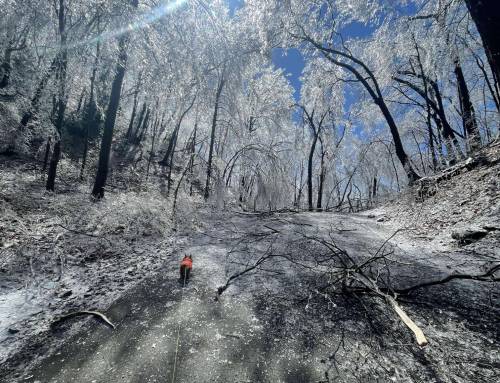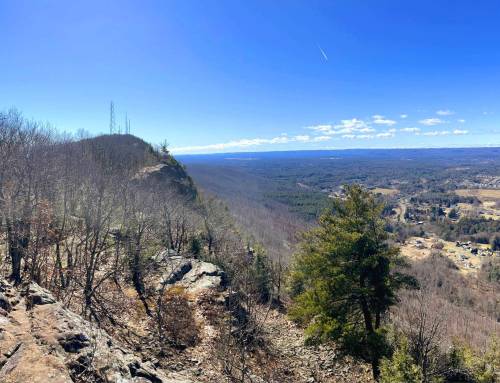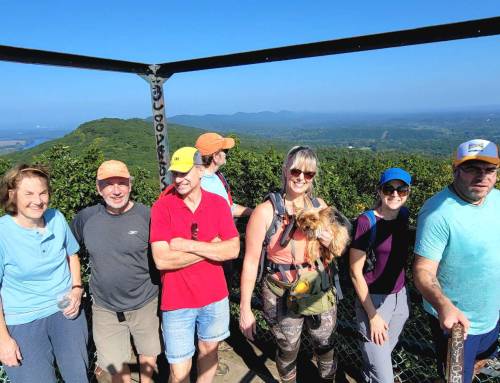Summit house popularity soared in New England during the mid to late 1800s. Many visitors travelled to mountaintops during warmer months to relax and escape the heat. Mount Nonotuck’s spectacular view attracted visitors from all over.
Holyoke entrepreneur William Street and a partner capitalized on this scenic site. They built a three-story 12-room hotel with five guestrooms It opened on July 4. Called The Eyrie Housr it looked like its namesake “eyrie” – an eagle nest perched high on a remote, commanding place.























The Eyrie House already had nearby competition, The Prospect House, across the Connecticut River on Mount Holyoke. The rivalry for customers became fierce! Mr. Street had to innovate. Street bought more land to expand the resort. He attracted more customers with popular pastimes. The hotel grounds featured a picnic grove, croquet court, pavilion for large festive parties, concerts and roller skating! Visitors along the main path saw a curious collection of live and taxidermy animals Around the outside of the hotel, “promenades,” long elevated wooden walkways, enhanced views of the valley below. The hotel grew and grew! By 1882 the hotel had 30 guestrooms, dining rooms, and separate men’s and women’s parlors.
Ten years later Mr. Street started two new ambitious projects to attract more customers; a larger stone hotel to replace the aging Eyrie House, and then an inclined railway to improve visitor access from below. Competition from Mount Holyoke’s Prospect House, Mountain Park amusement park, and the grand Mount Tom summit pavilion with its new inclined railroad drew customers away. An economic depression ate into his income and his ability to make any more improvements.
For almost 40 years Eyrie House enjoyed success. It all came to a sudden end on an early spring day in 1901. Mr. Street discovered several of his horses had died. Unable to dig on the rocky summit, he cremated them. The fire died down and he retired for the evening. He was later awakened by a roar. Wind had re-ignited the fire! The flames had already consumed the pavilion and now spread to the hotel. The great Eyrie House burned to the ground! A total loss.
Unfortunately, Mr. Street was underinsured. Of the $10,000 in losses, he collected only $2,000, not enough to rebuild Eyrie House or complete the new hotel and inclined railway. He still owned this mountain site, but abandoned any new hotel construction.
In 1903, Mount Tom State Reservation was created. The Reservation Commissioners wanted to include Mr. Street’s land. Mr. Street asked for $25,000 for his property, but was only offered $5,000. After years of debate the Commissioners deposited the $5,000 into a bank account for Street and took the land by eminent domain. Bitter until his death in 1918, Mr. Street never accepted the state’s money.
Courtesy DCR Eyrie Tour.
Sunday’s flash hike took us to Mount Tom State Reservation in Holyoke starting on the New England Trail from parking at the upper pavilion, walk down Reservoir Road and you will see the white blaze on your left. We hiked to Goat Peak to Dry Knoll and to Eyrie House following the ridgeline on the NET. A few ups and downs on this section, a very moderate hike. We returned on a loop following the John McCool Trail to Dynamite back to Reservoir Road. The trail climbs north to the ridgeline where the Goat Peak observation tower is located with spectacular views of the Connecticut River Valley, Dry Knoll has a great view of the 0xbow, then to Mount Nonotuck, dropping down onto an old carriage road that was once used for visitors to the Eyrie House, a 19th century mountain top hotel. 3.9 mile loop.
Visit our blog for all of our adventures! We are on Instagram TikTok Pinterest Twitter YouTube Meetup @hilltownhikers want to come along on these hikes? Become a member at www.hilltownhikers.com








Leave a Reply